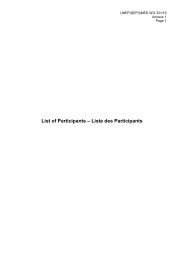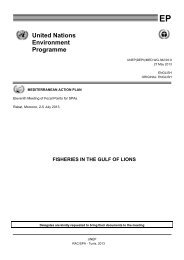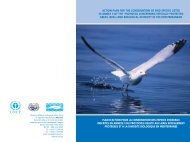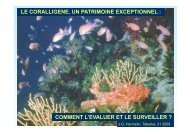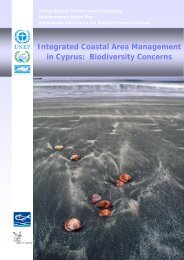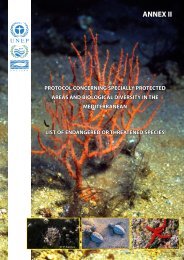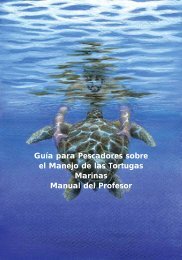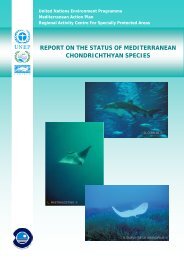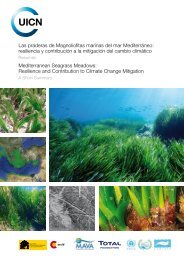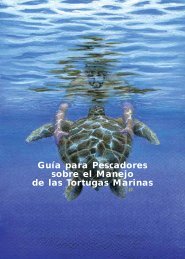Proceedings of the Second Mediterranean Symposium on Marine
Proceedings of the Second Mediterranean Symposium on Marine
Proceedings of the Second Mediterranean Symposium on Marine
Create successful ePaper yourself
Turn your PDF publications into a flip-book with our unique Google optimized e-Paper software.
J<strong>on</strong>ge et al., 2002). Nutrient c<strong>on</strong>centrati<strong>on</strong>s in water al<strong>on</strong>e are not indicative <str<strong>on</strong>g>of</str<strong>on</strong>g><br />
eutrophicati<strong>on</strong> status, especially in shallow ecosystems, since primary producers<br />
assimilate <str<strong>on</strong>g>the</str<strong>on</strong>g> nutrients very efficiently and resp<strong>on</strong>d n<strong>on</strong>-linearly and self-accelerating<br />
when certain nutrient boundaries are crossed (Duarte, 1995). High organic c<strong>on</strong>tent <str<strong>on</strong>g>of</str<strong>on</strong>g><br />
sediment, in additi<strong>on</strong>, could be toxic to marine angiosperms. Eutrophicati<strong>on</strong> is better<br />
indicated by its symptoms, which in <str<strong>on</strong>g>the</str<strong>on</strong>g> lago<strong>on</strong>s include shifts in species compositi<strong>on</strong><br />
from angiosperms to <str<strong>on</strong>g>the</str<strong>on</strong>g> dominance <str<strong>on</strong>g>of</str<strong>on</strong>g> opportunistic and <str<strong>on</strong>g>of</str<strong>on</strong>g>ten bloom forming<br />
seaweeds (Harlin, 1995; Schramm and Nienhuis, 1996). This predictable successi<strong>on</strong>al<br />
dynamic <str<strong>on</strong>g>of</str<strong>on</strong>g> macrophytes is induced also by o<str<strong>on</strong>g>the</str<strong>on</strong>g>r kinds <str<strong>on</strong>g>of</str<strong>on</strong>g> human disturbance, e.g.<br />
bottom-trawling, overharvesting <str<strong>on</strong>g>of</str<strong>on</strong>g> grazers or predators and is in accordance to classical<br />
<str<strong>on</strong>g>the</str<strong>on</strong>g>ory <str<strong>on</strong>g>of</str<strong>on</strong>g> r- and K-selecti<strong>on</strong>.<br />
The use <str<strong>on</strong>g>of</str<strong>on</strong>g> benthic macrophytes as bioindicators <str<strong>on</strong>g>of</str<strong>on</strong>g> eutrophicati<strong>on</strong> and <str<strong>on</strong>g>of</str<strong>on</strong>g> water quality<br />
in general, several c<strong>on</strong>cepts, and numerical techniques (indicator taxa, diversity and biotic<br />
indices, multivariate tools) have been developed. Although compositi<strong>on</strong> analysis at<br />
species level is <str<strong>on</strong>g>of</str<strong>on</strong>g>ten measured, a more predictive science might be achieved by using<br />
appropriate functi<strong>on</strong>al classificati<strong>on</strong>s. They could reduce <str<strong>on</strong>g>the</str<strong>on</strong>g> apparent complexity <str<strong>on</strong>g>of</str<strong>on</strong>g><br />
ecological systems and allow comparis<strong>on</strong>s between communities with little species<br />
overlap. Fur<str<strong>on</strong>g>the</str<strong>on</strong>g>rmore, <str<strong>on</strong>g>the</str<strong>on</strong>g>y could help to develop user-friendly protocols and costeffective<br />
m<strong>on</strong>itoring systems.<br />
The idea <str<strong>on</strong>g>of</str<strong>on</strong>g> defining plant types that are in some way related to ecosystem functi<strong>on</strong> is<br />
not new. For seaweeds, Littler and Littler (1980) have proposed functi<strong>on</strong>al groups, that<br />
irrespective <str<strong>on</strong>g>of</str<strong>on</strong>g> phylogeny, are similar in morphology and similar in <str<strong>on</strong>g>the</str<strong>on</strong>g>ir resp<strong>on</strong>ses to<br />
certain ecosystem functi<strong>on</strong>s, e.g. productivity, grazing. Orfanidis et al. (2001, 2003) have<br />
included seagrasses in this form-functi<strong>on</strong> system and <str<strong>on</strong>g>the</str<strong>on</strong>g>n have used it to divide <str<strong>on</strong>g>the</str<strong>on</strong>g><br />
benthic macrophytes in two differently resp<strong>on</strong>ding to envir<strong>on</strong>mental disturbance groups,<br />
<str<strong>on</strong>g>the</str<strong>on</strong>g> late-successi<strong>on</strong>al (K-selecti<strong>on</strong>) and <str<strong>on</strong>g>the</str<strong>on</strong>g> opportunistic (r-selecti<strong>on</strong>). The result <str<strong>on</strong>g>of</str<strong>on</strong>g> this<br />
approach, which explains general macrophyte patterns across a polluti<strong>on</strong> gradient mainly<br />
through <str<strong>on</strong>g>the</str<strong>on</strong>g>ir competitive abilities (Sommer and Worm, 2002), was <str<strong>on</strong>g>the</str<strong>on</strong>g> Ecological<br />
evaluati<strong>on</strong>-EEI index.<br />
In this study we m<strong>on</strong>itored <str<strong>on</strong>g>the</str<strong>on</strong>g> marine benthic macrophytes across an eutrophicati<strong>on</strong><br />
gradient <str<strong>on</strong>g>of</str<strong>on</strong>g> selected Eastern Maced<strong>on</strong>ian & Thrace lago<strong>on</strong>s. The aims were (1) to select<br />
reliably interpretable signals <str<strong>on</strong>g>of</str<strong>on</strong>g> macrophyte resp<strong>on</strong>ses by critically comparing different<br />
parameters <str<strong>on</strong>g>of</str<strong>on</strong>g> compositi<strong>on</strong> analysis, based at species- and functi<strong>on</strong>al group-level, and <str<strong>on</strong>g>the</str<strong>on</strong>g><br />
biotic index EEI, (2) to suggest user-friendly protocols for a cost-effective m<strong>on</strong>itoring<br />
program, e.g. WFD.<br />
MATERIAL AND METHODS<br />
Study area. The studied lago<strong>on</strong>s bel<strong>on</strong>g to <str<strong>on</strong>g>the</str<strong>on</strong>g> Nestos River and Vist<strong>on</strong>ida estuarine<br />
system catchments (Fig. 1). They are protected by Ramsar c<strong>on</strong>venti<strong>on</strong> and were<br />
suggested to be included in <str<strong>on</strong>g>the</str<strong>on</strong>g> European Natura 2000 network. Traditi<strong>on</strong>al fish<br />
aquaculture (mesh frames, stati<strong>on</strong>ary entrapment system) is <str<strong>on</strong>g>the</str<strong>on</strong>g> main commercial use <str<strong>on</strong>g>of</str<strong>on</strong>g><br />
<str<strong>on</strong>g>the</str<strong>on</strong>g> lago<strong>on</strong>s. The main nutrient sources <str<strong>on</strong>g>of</str<strong>on</strong>g> <str<strong>on</strong>g>the</str<strong>on</strong>g> Nestos lago<strong>on</strong>s are agricultural run-<str<strong>on</strong>g>of</str<strong>on</strong>g>fs<br />
ACTES DU DEUXIEME SYMPOSIUM MEDITERRANEEN SUR LA VEGETATION MARINE (ATHENES, 12-13 DECEMBRE 2003)<br />
187



